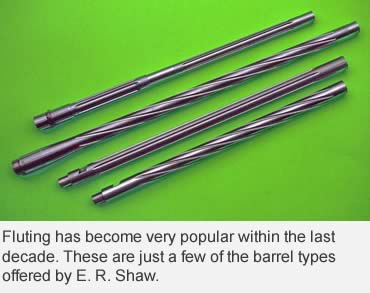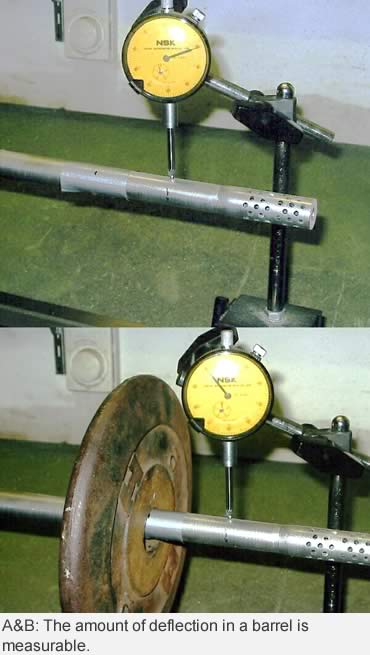By Jon R. Sundra
Fluting makes a barrel distinctive, but there are other benefits, too.
Photo: Fluting usually does not extend the entire length of the barrel.
One of the most distinctive options available to anyone contemplating the purchase of a rifle is a fluted barrel. It can be a sporter-weight hunting rifle or a varminter. It doesn’t matter. Fluting sets it apart visually from the run of the mill.
Some fluted barrels are more cosmetic than functional, with narrow, shallow flutes. Others are as deep as the barrel wall thickness will allow.
There are even spiral-fluted barrels. E.R. Shaw (ershawbarrels.com), holds two patents on spiral fluting, so when you see a barrel that looks like it’s wearing its rifling on the wrong side, it’s gotta be a Shaw barrel!
And speaking of cosmetics, some gun and barrel makers blacken their fluted stainless barrels, then final polish them on the outside so the flutes remain black and in sharp contrast to the barrel’s silvery outer surface. Weatherby was the first gun manufacturer to do it, but a few others have since adopted the procedure.
 Blackened flutes just make a gun that much more distinctive, and I for one really like it.
Blackened flutes just make a gun that much more distinctive, and I for one really like it.
Fluting makes a gun stand out, but it also cools faster than a smooth barrel of the same weight. If a barrel cools faster, it also heats up faster because there’s less metal involved. So if a rifle has a tendency to start walking its point of impact on the target as the barrel heats, it starts doing so faster and/or with fewer shots than a smooth barrel.
Fluting also shaves weight from what is usually the heaviest single component of the shooting system. As an example of how much weight can be reduced by fluting, consider two barrels of identical length and contour, one fluted and one not.
A No. 3 contour Pac-Nor barrel in 7mm caliber measures 24 inches long and is .625-inch at the muzzle. I used Pac-Nor because you can actually plug in specs and compare barrel weights on their website. The sample barrel without fluting weighs 3.51 pounds. The same barrel with eight 17-inch flutes weighs 2.74 pounds.
 I specified 17-inch-long flutes because that’s their average length on a 24-inch barrel. You see, fluting is generally done only on that portion of the barrel where there’s a straight taper to the muzzle. Given the typical sporter contour, the flutes generally begin about 5 inches ahead of the receiver ring and end about 1.5 inches behind the muzzle.
I specified 17-inch-long flutes because that’s their average length on a 24-inch barrel. You see, fluting is generally done only on that portion of the barrel where there’s a straight taper to the muzzle. Given the typical sporter contour, the flutes generally begin about 5 inches ahead of the receiver ring and end about 1.5 inches behind the muzzle.
Now we come to the one advantage claimed for fluting that is generally taken for granted, and that is that fluting makes a barrel stiffer. I always assumed that contention was true, but is it really? Looking at a gun barrel, even a lightweight one, it’s hard to imagine that it’s anything but stiff. It is therefore difficult to imagine it flexing to any extent, but it definitely does as a bullet accelerates down the bore.
Imagine a garden hose stretched in a straight line along the ground. If you pick up one end of it and shake it violently up and down, a wave action is created that travels down the length of the hose. A gun barrel does much the same when a bullet is sent through it. It seems logical then that the stiffer the barrel, the more accurate it can be. In the real world though, so long as a barrel’s harmonics are consistent and the muzzle is always in precisely the same attitude at the bullet’s moment of departure, a whippy barrel can theoretically shoot groups just as small as a heavier one. One need only look at benchrest records comparing Light Varmint (10-pound) and Heavy Varmint (13.5-pound.) rifles. Most of the miniscule difference in accuracy is due to the fact you can hold a heavier gun steadier.
 Another common sense notion about stiffness comes from everyday experience. An ordinary sheet of paper goes limp when you pick it up at one end. Now fold that paper in half lengthwise so there’s a crease down the middle, and pick up the paper at the same place. The paper will stand straight out because it’s much stiffer.
Another common sense notion about stiffness comes from everyday experience. An ordinary sheet of paper goes limp when you pick it up at one end. Now fold that paper in half lengthwise so there’s a crease down the middle, and pick up the paper at the same place. The paper will stand straight out because it’s much stiffer.
Another good example is a steel tape measure. If it were flat, it would not extend far. So chalk up another seemingly intuitive thing that tells us a fluted barrel must be stiffer than a smooth barrel.
Fact of the matter is, fluting does not stiffen a barrel as logic would seem to dictate, not according to the several structural engineers and metallurgists who wrote me after I had said so in print. The gist of what they all said was that whenever you remove material from an object, you weaken it. More specifically, if we were to take an unfluted barrel, measure its deflection, flute it, and measure its deflection again, we’d find the unfluted pipe deflecting less.
This can be demonstrated quite graphically by a procedure my friend and colleague John Dustin came up with to satisfy his own curiosity. John is a well-known accuracy gunsmith and competitive benchrest shooter as well as a writer, and he devised a simple demonstration using a lathe chuck, a weight and a dial indicator.
He took a chambered, unfluted 6.5mm barrel and chucked the unthreaded shank portion of it into his lathe, applying a witness mark on both so in the future he could again align the two with precisely the same orientation relative to one another. He also noted the amount of torque applied when locking the jaws of the chuck so there would be no disparity there.
 At the unsupported muzzle end of the barrel, a dial indicator was placed and set at an arbitrary value. John then placed a 10-pound weight slightly behind the dial indicator to measure the amount of deflection or “bend.” The same barrel was then fluted and subjected to the same procedure. The results? The unfluted barrel deflected .030 inch when the weight was applied; .040 inch after it was fluted, which works out to approximately 25 percent more deflection for the fluted barrel.
At the unsupported muzzle end of the barrel, a dial indicator was placed and set at an arbitrary value. John then placed a 10-pound weight slightly behind the dial indicator to measure the amount of deflection or “bend.” The same barrel was then fluted and subjected to the same procedure. The results? The unfluted barrel deflected .030 inch when the weight was applied; .040 inch after it was fluted, which works out to approximately 25 percent more deflection for the fluted barrel.
I guess the conclusion that could be drawn from all this is that fluting does lighten a barrel, and it does allow it to cool faster. The latter is of little significance in the real world, but the weight-saving aspect is certainly real and worthwhile to those to whom weight is an important consideration. As for the cosmetics, that’s a subjective thing, but I for one think it looks cool, especially when it’s raw stainless and the flutes are blackened.
Read Recent GunHunter Articles:
• Make Your Deer Rifle Work Overtime: Turn your big-game rifle into a jack of all trades with light and heavy loads.
• Which .22 Centerfire? It’s hard not to like cartridges with names like Swift, Hornet and Fireball. Here’s what they do best in the field.
This article was first printed in the September 2011 edition of Buckmasters GunHunter Magazine. Subscribe today to have GunHunter delivered to your home.